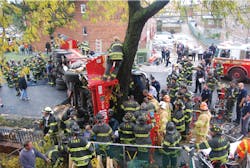Good News: Line-of-Duty Deaths Down in 2010
A year ago, this column touted the fact that firefighter line-of-duty deaths had fallen to their lowest levels in years. We also said that although this news was encouraging, one year a trend does not make.
Well, for the second time in as many years, the number of firefighter line-of-duty deaths dropped significantly in 2010, to their lowest level since statistics started to be kept in 1977. Preliminary data that was just released reports that 85 firefighters died in the line of duty in 2010. As in past years, heart attacks and strokes were the leading causes of fatalities, accounting for 51 deaths (60%). Motor vehicle accidents ranked second, accounting for 11 deaths (12.9%). However, also as in past years, this number could have been even lower had all firefighters worn seatbelts. Twenty of the fallen firefighters were between 51 and 60 years old and 25 firefighters were 61 or older.
Perhaps the work of so many to make a difference in firefighter safety, which reduces deaths and injuries, is finally starting to pay off. This includes individual firefighters who have finally started to take their own personal safety seriously. But whatever the reason, may we all keep up the good work so that this downward trend continues.
Certainly, two individuals who fit the aforementioned category of promoting firefighter safety and reducing line-of-duty deaths and firefighter injuries are my bosses at the FDNY, Fire Commissioner Salvatore Cassano and Chief of Department Edward Kilduff. Both men seem to work tirelessly promoting firefighter safety, not only in the FDNY, but nationally as well and have had a huge impact on both fronts.
In the latest attempt to increase not only firefighter safety, but the safety of the civilians in New York City, the FDNY is piloting a new modified-response policy. This policy was originally started late last year for a three-month trial period in Queens and was just extended for another three months; so far, so good.
In 2009, there were 148 accidents involving FDNY fire apparatus that were responding to calls for water leaks, gas leaks, toppled trees, foul odors, false alarms, faulty sprinklers and alarm activations. Calls for non-life-threatening emergencies are expected to reach 230,000 this year after steadily increasing from 41,054 in 1969. In October 2009, a second-due ladder company flipped onto its side and skidded into a tree after colliding with a third-due engine company responding to a report of an odor of gas in Brooklyn, pinning the driver of the ladder truck and injuring many more (see photo on page 114). These statistics caused Commissioner Cassano to act by initiating the modified-response policy in Queens.
This FDNY pilot program changes the response to some types of alarms. All single units responding to Group 1 responses, which include water leaks, trees down, lock-ins, salvage operations, and ERS no-contact street boxes between the hours of 11 P.M. and 8 A.M. will cause these units to respond on a signal 10–20, defined as: "Responding units are to proceed at a reduced speed. No warning devices are to be used and all traffic regulations are to be observed. When a single unit responding to a Group 1 call receives additional information, or the dispatcher fills out the assignment, the officer or the assigned battalion chief may direct an emergency response, if warranted."
For Group 2 responses, which would normally require a full first-alarm assignment of three engine companies, two ladder companies and a battalion chief, only the first-due unit pair (engine and truck) would respond in the emergency mode with lights and sirens, while all other units would respond on a 10–20 signal. Group 2 responses include odors of gas or fumes, sprinkler/valve alarms, automatic alarms, and electrical and manhole emergencies.
As with any new program, training and culture change are key to its success. Training programs have been developed to accomplish this goal.
What are the anticipated benefits of this policy?
- Reduce accidents
- Avoid disruption of traffic by pushing civilian vehicles into traffic
- Reduce fuel consumption and maintenance costs
- Keep second- and third-due units closer to the center of their response areas and not deplete response neighborhoods of the closest units needlessly
- Make second- and third-due units available for priority reassignment, if necessary, for structural fires, cardiac conditions, etc.
We will continue to monitor and report the department's progress in the weeks and months ahead with this firefighter safety initiative.
MICHAEL WILBUR, a Firehouse® contributing editor, is a lieutenant in the New York City Fire Department, assigned to Ladder Company 27 in the Bronx, and has served on the FDNY Apparatus Purchasing Committee. He consults on a variety of apparatus-related issues around the country. For further information, please access Wilbur's website at www.emergencyvehicleresponse.com.
